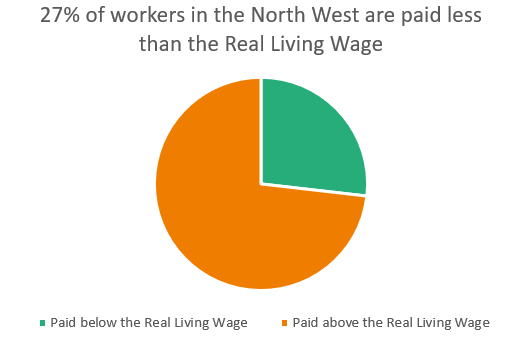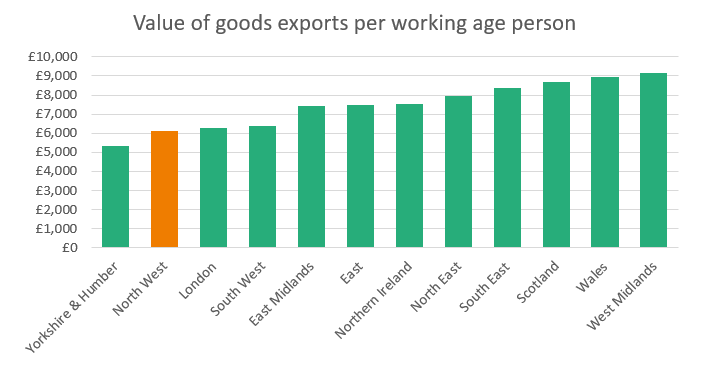REGIONAL ANALYSIS: North West
Article
This analysis was handed out at our event Economic Justice for the North West. The event was the North West instalment in a UK-wide series of public meetings held by the IPPR Centre for Economic Justice.
Pay - Average earnings in the North West grew from £440 per week in 2011 to £510 per week in 2018. This equates to growth of 2.1% per year. This growth was above average for the UK as a whole. However, around three in ten workers are still paid less than the Real Living Wage of £9.00 per hour (this is estimated to be the minimum needed to afford the cost of living).1 International Competitiveness - The value of the goods exported in the North West in 2018 was £28bn, or £6,100 per working age person.2 Relative to the size of its population, the North West exported fewer goods than any other region in the UK other than Yorkshire and the Humber, and a third lower than the West Midlands. This is despite the proportion of jobs in manufacturing being very similar in the two regions, at around one in ten.3
International Competitiveness - The value of the goods exported in the North West in 2018 was £28bn, or £6,100 per working age person.2 Relative to the size of its population, the North West exported fewer goods than any other region in the UK other than Yorkshire and the Humber, and a third lower than the West Midlands. This is despite the proportion of jobs in manufacturing being very similar in the two regions, at around one in ten.3
 International Competitiveness - The value of the goods exported in the North West in 2018 was £28bn, or £6,100 per working age person.2 Relative to the size of its population, the North West exported fewer goods than any other region in the UK other than Yorkshire and the Humber, and a third lower than the West Midlands. This is despite the proportion of jobs in manufacturing being very similar in the two regions, at around one in ten.3
International Competitiveness - The value of the goods exported in the North West in 2018 was £28bn, or £6,100 per working age person.2 Relative to the size of its population, the North West exported fewer goods than any other region in the UK other than Yorkshire and the Humber, and a third lower than the West Midlands. This is despite the proportion of jobs in manufacturing being very similar in the two regions, at around one in ten.3
In exports of services, the North West is performing much better. In 2016/17 the North West exported £13bn of services, or £3,000 per working-age person – more per person than any of the rest of the North, the Midlands and Wales.4
Government Investment - Government investment per person in housing and amenities has been among the lowest in the North West over the past 5 years , with estimated average investment of just £60 per person per year. This is significantly lower than the UK average of £110 per person.5
References
- IPPR analysis, Annual Survey of Hours and Earnings (ONS)
- IPPR analysis, using Goods Exports by Region (uktradeinfo) and working age population estimates (ONS)
- Workforce jobs by industry (SIC 2007) – seasonally adjusted (ONS)
- IPPR analysis, uses Service Exports by region (experimental statistics, ONS) and working age population estimates by region (ONS)
- IPPR analysis, using HMT Country and Regional Analysis, identifiable capital expenditure on housing and amenities 2013-14 to 2017-18 and population estimates by region (ONS)
Related items

Change you can board: Delivering better, greener buses
The bus services bill is an opportunity to ensure reform really means thriving, green 21st century local bus networks in England.
Harry Quilter-Pinner on BBC Radio 4 Today discussing political donations

Modernising elections: How to get voters back
Elections are the defining feature of modern democracy. They are the process by which we express a desired future en masse. It is the mass dimension that matters most; it is the mass dimension that is receding.